flatlander937
Member
- :
- '11 Mazda2 Sport
Well you're in the right thread!
For some background... I'm a tech at a large used car dealership. There is a vehicle that was sold, clutch slips in 6th gear and had excessive clutch pedal effort. I found the Mazda TSB so of course ordered the parts planning on replacing the pedal, clutch and pressure plate, and resurfacing the flywheel.
Come to find out the clutch that the vehicle had in it(from a previous owner) is aftermarket, an ACT clutch.
It is quite interesting that this is supposed to be an upgrade for these vehicles, when in fact comparing them side by side proves this may not be the case... at least when it comes to friction surface area. edit: after further reading, surface area has nearly nothing to do with torque holding ability. Just heat dissipation and longevity.
First the pics... Mazda on left(these are the revised parts found in the clutch effort TSB), ACT on right:
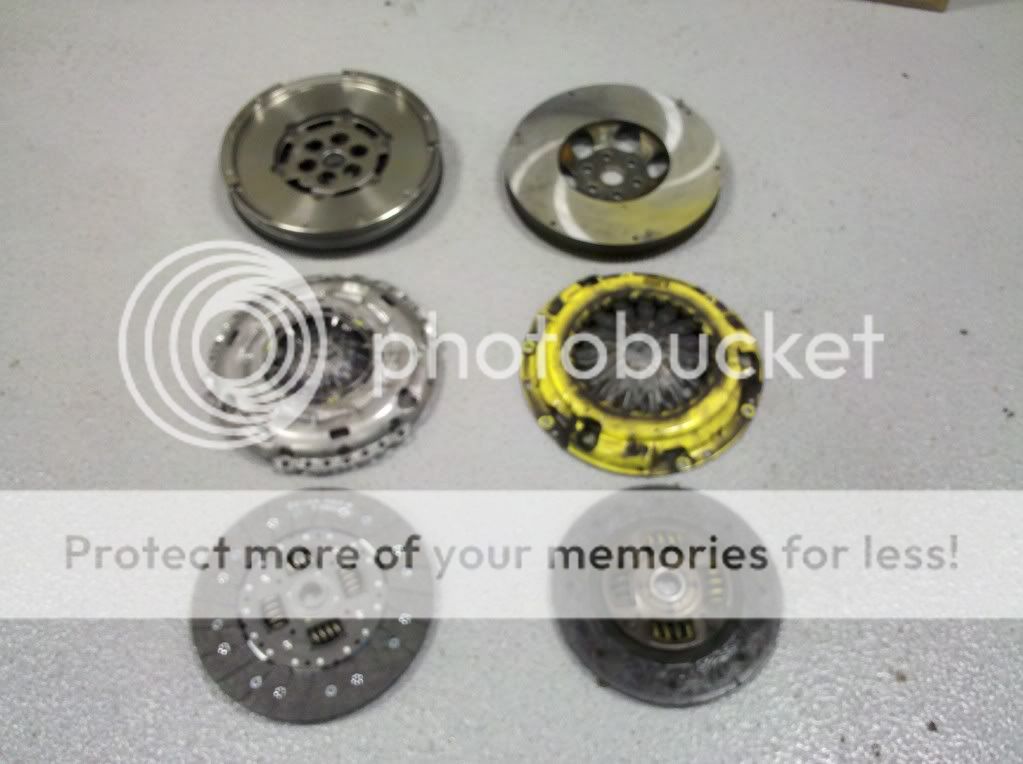
The Mazda clutch disc is 9.75" in diameter, the ACT is 9.50" in diameter:

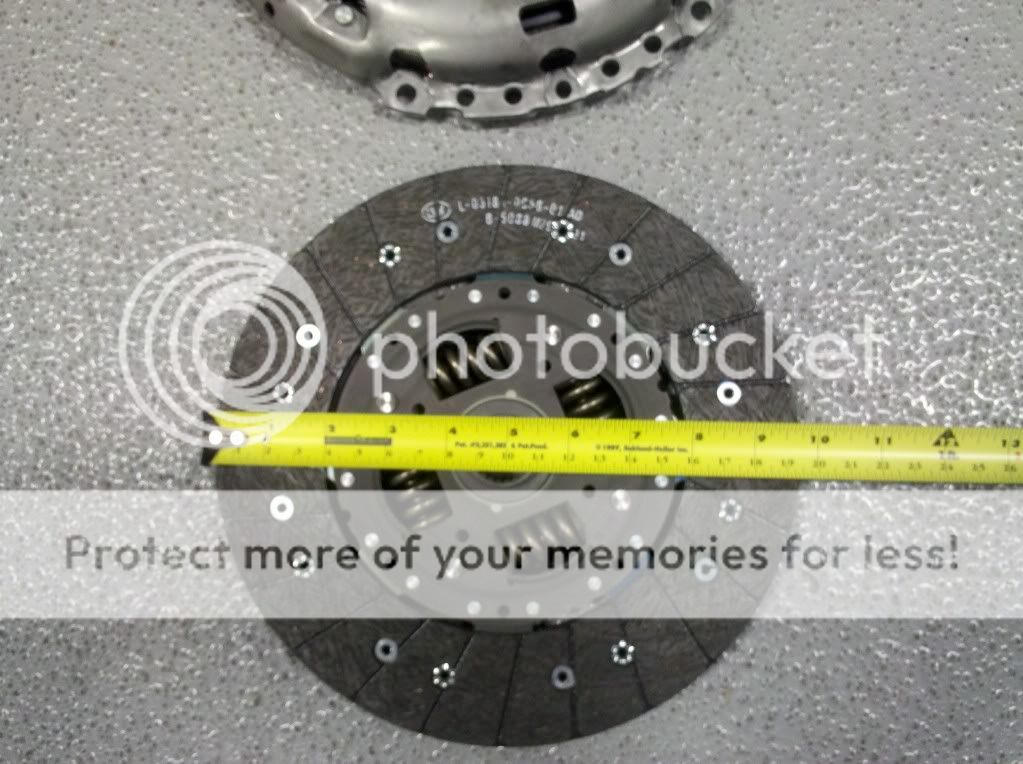
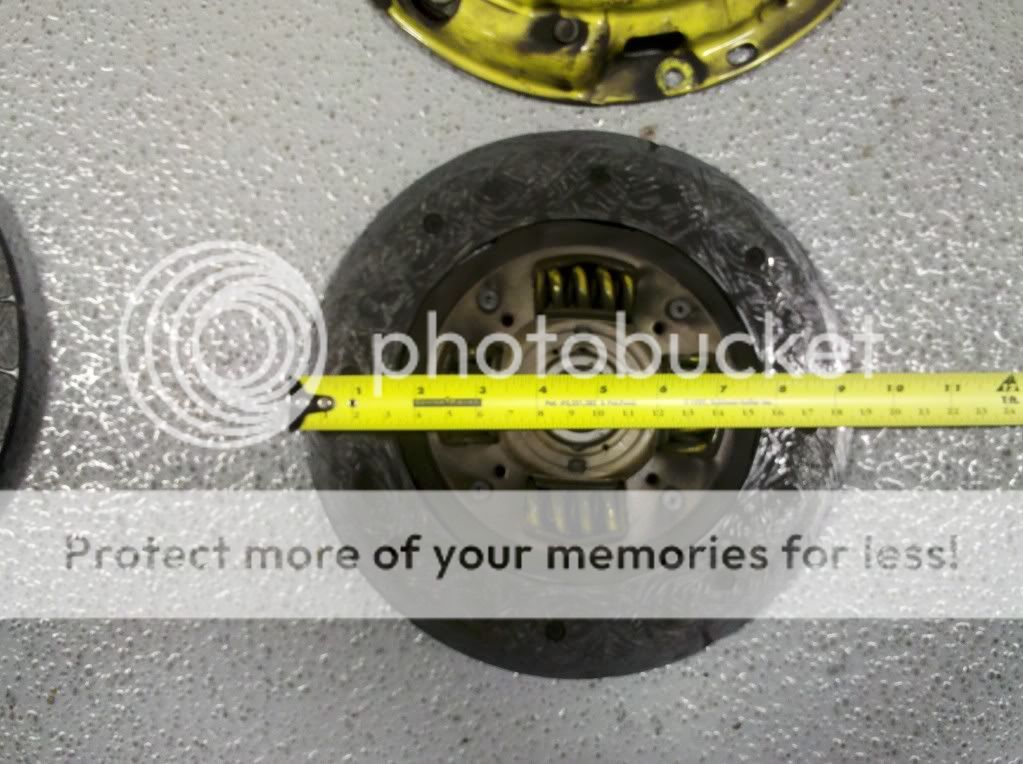
The pressure plate assemblies. I am not sure how spring stuff is calculated, but it -appears- the ACT clutch will be much heavier... which could give you the false illusion that it is going to hold more power... whether true or not.
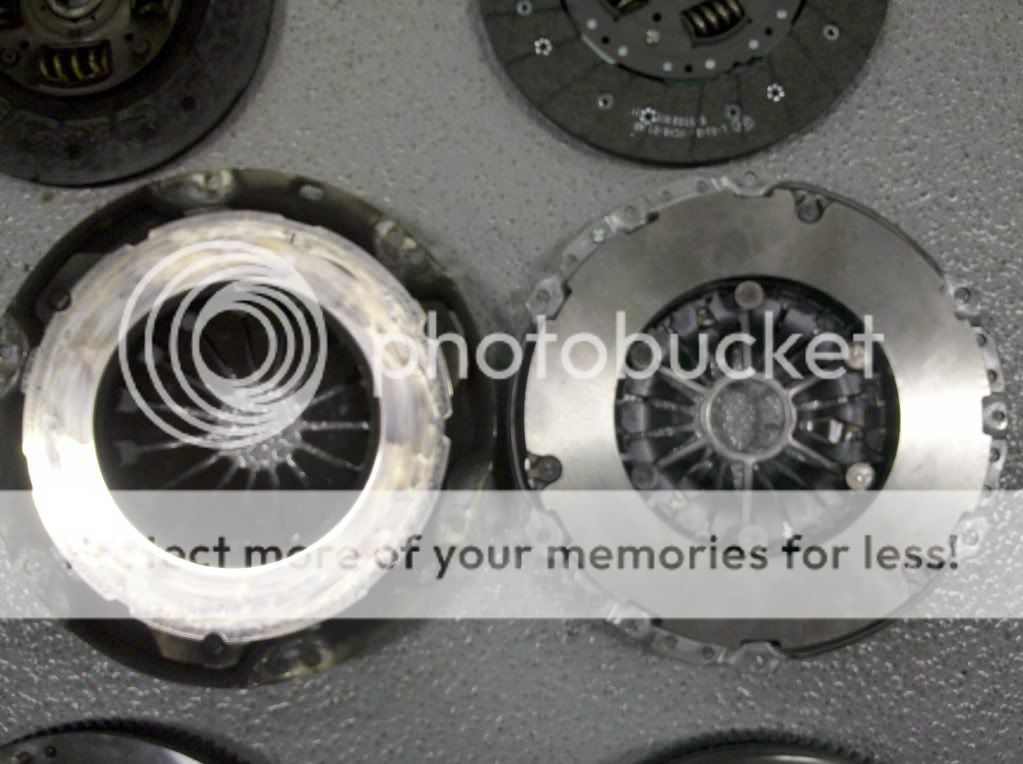
And here you can see the dual mass flywheel that the MS6 comes with.
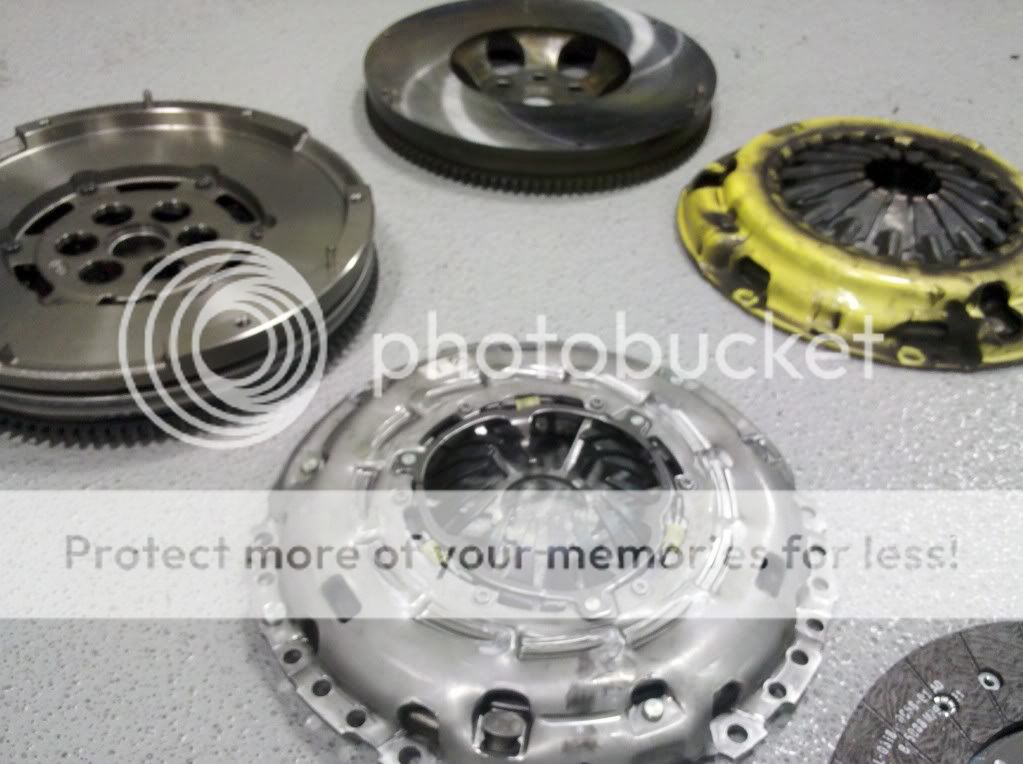
I did the math on the surface areas of each clutch disc...
The outter diameters of the discs are 9.75(Mazda) and 9.50(ACT)... not a big difference. To be usable for calculation of circle area, we need the radius of those.
Mazda outter radius: 4.875"
ACT outter radius: 4.75"
The area of a circle is pi x r2 with pi = 3.141592653589793
Because I am lazy, I actually used this calculator to speed things along:
http://www.basic-mathematics.com/area-of-a-circle-calculator.html
So the overall area of the Mazda clutch disc is 74.66in sq
Overall area of the ACT clutch disc is 70.88in sq.
BUT WAIT THERE'S MORE!!!
The clutch disc friction area isn't a complete circle... it's only on the outer ring of the circle. We just calculated the area based on the outside edge of the friction area... so now we need to calculate the INSIDE edge of that friction material... with intentions of taking the outside area minus inside area... which will leave us with the area of the actual friction surface.
I measured the width of the clutch linings from ID to OD... these are the results:
Mazda: 1.875"(that's 1-7/8) wide
ACT: 1.125(that's 1-1/8) wide
By knowing this number, we can subtract this number from the OD radius... to get the ID radius that we need.
Mazda: 3" radius inside the friction area
ACT: 3.625(that's 3-5/8)" radius inside the friction area
That is a big difference when you are talking areas of circles... how much you ask? Let's find out by first turning those radii into surface area #s...
Mazda: 3" radius circle = 28.27in sq
ACT: 3.625" radius circle = 41.28in sq
So now we can take the big radii minus the small radii to get the total surface area of the friction surface only:
Mazda: 74.66 - 28.27 = 46.39in sq
ACT: 70.88 - 41.28 = 29.60in sq
BUT WAIT!
That is only for ONE SIDE of the disc... so take those numbers x2 for the actual friction surface working areas:
Mazda: 92.78in sq total
ACT: 59.20in sq total
That is a 33.58in sq difference between the two!!
That means the ACT clutch has 36.19% LESS friction area than the OEM Mazda clutch.
I'm sure it is all a wash when you consider that ACT advertises a 48% increase in clamping power... but that's also because if they didn't it would be weaker than stock for sure. Again these calculations I did really mean nothing other than just knowing the surface area of the clutch linings. Read my next post further down for more info.
I'll end in saying that I have no idea what the "clamping forces" actually are in either clutch, or how big of an effect that having the Mazda clutch 1/4" larger in outer diameter is vs the ACT clutch(because having the friction surface further out = bigger lever arm to resist slipping)... but maybe this will make some people think twice before throwing in something other than an OEM Mazda clutch but only wanting a "stock replacement" equivalent.
I'll also say that there are just too many other variables in designing clutches that I know are far beyond my limited knowledge... I'm sure ACT builds a good product, but you've got to wonder why they would utilize a smaller disc w/ less surface area.
And it turns out I was definitely right about this... I'm not an engineer, I just like to learn the how and why of things. Read my next post below to see what really matters in clutch holding power.
-----
On a side note the reason the ACT flywheel is resurfaced is because I took it off a day before I got the new Mazda parts... didn't think to check and make sure the flywheel is OEM or anything... and for some stupid reason I didn't look real close at the pressure plate either despite it being yellow... duh. So let my stupidity be a lesson to pay attention to the details. (lol2)
For some background... I'm a tech at a large used car dealership. There is a vehicle that was sold, clutch slips in 6th gear and had excessive clutch pedal effort. I found the Mazda TSB so of course ordered the parts planning on replacing the pedal, clutch and pressure plate, and resurfacing the flywheel.
Come to find out the clutch that the vehicle had in it(from a previous owner) is aftermarket, an ACT clutch.
It is quite interesting that this is supposed to be an upgrade for these vehicles, when in fact comparing them side by side proves this may not be the case... at least when it comes to friction surface area. edit: after further reading, surface area has nearly nothing to do with torque holding ability. Just heat dissipation and longevity.
First the pics... Mazda on left(these are the revised parts found in the clutch effort TSB), ACT on right:

The Mazda clutch disc is 9.75" in diameter, the ACT is 9.50" in diameter:



The pressure plate assemblies. I am not sure how spring stuff is calculated, but it -appears- the ACT clutch will be much heavier... which could give you the false illusion that it is going to hold more power... whether true or not.

And here you can see the dual mass flywheel that the MS6 comes with.

I did the math on the surface areas of each clutch disc...
The outter diameters of the discs are 9.75(Mazda) and 9.50(ACT)... not a big difference. To be usable for calculation of circle area, we need the radius of those.
Mazda outter radius: 4.875"
ACT outter radius: 4.75"
The area of a circle is pi x r2 with pi = 3.141592653589793
Because I am lazy, I actually used this calculator to speed things along:
http://www.basic-mathematics.com/area-of-a-circle-calculator.html
So the overall area of the Mazda clutch disc is 74.66in sq
Overall area of the ACT clutch disc is 70.88in sq.
BUT WAIT THERE'S MORE!!!
The clutch disc friction area isn't a complete circle... it's only on the outer ring of the circle. We just calculated the area based on the outside edge of the friction area... so now we need to calculate the INSIDE edge of that friction material... with intentions of taking the outside area minus inside area... which will leave us with the area of the actual friction surface.
I measured the width of the clutch linings from ID to OD... these are the results:
Mazda: 1.875"(that's 1-7/8) wide
ACT: 1.125(that's 1-1/8) wide
By knowing this number, we can subtract this number from the OD radius... to get the ID radius that we need.
Mazda: 3" radius inside the friction area
ACT: 3.625(that's 3-5/8)" radius inside the friction area
That is a big difference when you are talking areas of circles... how much you ask? Let's find out by first turning those radii into surface area #s...
Mazda: 3" radius circle = 28.27in sq
ACT: 3.625" radius circle = 41.28in sq
So now we can take the big radii minus the small radii to get the total surface area of the friction surface only:
Mazda: 74.66 - 28.27 = 46.39in sq
ACT: 70.88 - 41.28 = 29.60in sq
BUT WAIT!
That is only for ONE SIDE of the disc... so take those numbers x2 for the actual friction surface working areas:
Mazda: 92.78in sq total
ACT: 59.20in sq total
That is a 33.58in sq difference between the two!!
That means the ACT clutch has 36.19% LESS friction area than the OEM Mazda clutch.
I'm sure it is all a wash when you consider that ACT advertises a 48% increase in clamping power... but that's also because if they didn't it would be weaker than stock for sure. Again these calculations I did really mean nothing other than just knowing the surface area of the clutch linings. Read my next post further down for more info.
I'll end in saying that I have no idea what the "clamping forces" actually are in either clutch, or how big of an effect that having the Mazda clutch 1/4" larger in outer diameter is vs the ACT clutch(because having the friction surface further out = bigger lever arm to resist slipping)... but maybe this will make some people think twice before throwing in something other than an OEM Mazda clutch but only wanting a "stock replacement" equivalent.
I'll also say that there are just too many other variables in designing clutches that I know are far beyond my limited knowledge... I'm sure ACT builds a good product, but you've got to wonder why they would utilize a smaller disc w/ less surface area.
And it turns out I was definitely right about this... I'm not an engineer, I just like to learn the how and why of things. Read my next post below to see what really matters in clutch holding power.
-----
On a side note the reason the ACT flywheel is resurfaced is because I took it off a day before I got the new Mazda parts... didn't think to check and make sure the flywheel is OEM or anything... and for some stupid reason I didn't look real close at the pressure plate either despite it being yellow... duh. So let my stupidity be a lesson to pay attention to the details. (lol2)
Last edited:
